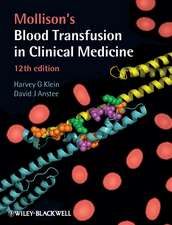31st Hemophilia Symposium: Hamburg 2000
Editat de I. Scharrer, W. Schrammen Limba Engleză Paperback – 22 oct 2001
Preț: 717.00 lei
Preț vechi: 754.74 lei
-5% Nou
Puncte Express: 1076
Preț estimativ în valută:
137.20€ • 146.71$ • 114.39£
137.20€ • 146.71$ • 114.39£
Carte tipărită la comandă
Livrare economică 17 aprilie-01 mai
Preluare comenzi: 021 569.72.76
Specificații
ISBN-13: 9783540421313
ISBN-10: 3540421319
Pagini: 320
Ilustrații: XXX, 287 p.
Dimensiuni: 155 x 235 x 17 mm
Greutate: 0.45 kg
Editura: Springer Berlin, Heidelberg
Colecția Springer
Locul publicării:Berlin, Heidelberg, Germany
ISBN-10: 3540421319
Pagini: 320
Ilustrații: XXX, 287 p.
Dimensiuni: 155 x 235 x 17 mm
Greutate: 0.45 kg
Editura: Springer Berlin, Heidelberg
Colecția Springer
Locul publicării:Berlin, Heidelberg, Germany
Public țintă
Professional/practitionerDescriere
Some 23. 5% of all members and patients of treatment centers completed the questionnaire. One striking fact is that participation was highest amongst elderly patients with severe hemophilia, whereas only 12. 2% of family members responded. Evaluation of the results revealed that the majority of participants prefer treat ment in a hemophilia treatment center with a high reputation, whereas only 2. 7% consider treatment in a specialized practice to be sufficient. The reasons for that are the necessity of the 24-h-availability of a physician, regular qualified examination of joints and muscles, documentation of product batches, laboratory tests and good cooperation with other faculties. As many as 68. 9% of the patients sometimes travel more than 200 km. What certainly plays a role here is trust in the treatment center and its physicians, for it is noticeable that irrespective of the fact that 74. 3% re quested standardized treatment regimens for all treatment centers, only about 20% would change to a nearer center. Treatment with factor concentrates is generally considered to be very safe. That is to say, 58. 1 % regard recombinant products to be very safe, whereas only 24. 3% assume this for plasma products. When compared, there were usually no major differences observed regarding outcome (factor consumption, duration of treat ment). Increase in maximum storage temperature (47. 2%) and half-life (73%) were the most frequent answers to the question of what features the products should have.
Cuprins
Presentation of the Johann-Lukas-Schoenlein-Award.- I. Epidemiology.- HIV Infection and Causes of Death in Patients with Hemophilia in Germany (Year 1999/2000 Survey).- Hemophilia 2000 — the Annual Survey of the Austrian Hemophilia Centers.- II. Inhibitors in Hemophilia.- Changes in Epitope Specificity and in Distribution of FVIII Antibodies during Immune Tolerance Therapy (ITT) in Hemophilia A Patients with FVIII Antibodies — a Case Report.- Clinical Experience with the Modified Bonn-Malmö Protocol since 1996.- Course of Inhibitors in mild Hemophilia A with and without Immune Tolerance Treatment.- III. Therapy and Monitoring of Bleeds in Acute- and Intensive Care Medicine.- Management of Bleeding in Surgery and Intensive Care.- IV.. Pediatric Hemostaseology.- Frequency and Profile of viral posttransfusional Infections in Patients from Hemophilia Center Timisoara.- Symptomatic Onset of severe Hemophilia A in Childhood is dependent on the Presence of Prothrombotic Risk Factors.- Differences between Neonates and Adults in Plasmin Inhibitory and Antifibrinolytic Action of Aprotinin.- Shorter PFA-100 Closure Times (CT) in Neonates than in Adults: Role of Red Cells, White Cells, Platelets, and von Willebrand Factor.- V. Free Lectures.- Efficacy and Safety of a High Purity Protein C Concentrate in the Management of Patients with severe Congenital Protein C Deficiency.- Respective Roles of Factors II, VII, IX, and X in the Procoagulant Activity of FEIBA.- Capillary Microscopic and Rheological Dimensions for the Diagnosis of von-Willebrand-Disease in Comparison with other Hemorrhagic Diatheses.- Evaluation of Denaturing High Performance Liquid Chromatography (DHPLC) in the Analysis of Hemophilia A.- Vla. Poster: Clinic and Casuistic.- Rheumatoid Arthritis in a Patient with Hemophilia Arthropathy — a Case Report.- Recurrent Fatal Intracranial Hemorrhage (ICH) in Two Non-Identical Twins suffering from Hemophilia B (Factor IX Activity < 1%).- Progression of Thrombosis under Low Molecular Weight Heparin without Heparin-Induced Thrombocytopenia in a young Man: a Case Report.- Cardiac Tamponade in a Patient with acquired Factor VIII Inhibitor and Chronic Renal Failure.- Endoscopic Cholecystectomy in a 55-year-old Patient with Heparin-Induced Thrombocytopenia Type II and Replacement of Mitral and Aortic Valve and Tricuspidal Valve Anular Plasty.- Vlb. Poster: Hemophilia.- Successful Orthopedic Operations in Hemophilic Adults with Inhibitors against Factor VIII.- Evaluation of Clinical Efficacy of rFVIIa in Pediatrics.- Risk Factors for Thrombosis in Hemophilia — an Analysis.- Status of Pain in Patients with severe Haemophilic Arthropathies.- Results of a 5-year Clinical Study with a B-domain Deleted FVIII Concentrate (rFVIII-SQ).- Outpatient Treatment with Radiosynoviorthesis in Hemophilic Arthropathy.- Requirements for Future Hemophilia Treatment from the Patients’ Point of View.- Vic. Poster: Hemorrhagic Diathesis.- Molecular Basis of von Willebrand Disease Type IIC Miami.- Hemorrhagic Diathesis through acquired Factor XIII Inhibitor.- Liver Transplantation in a Patient with severe von Willebrand Disease Type 3: Levels of von Willebrand Factor Following Transplantation.- Clincal Course and Laboratory Findings in a Patient with a New Mutation Causing Wiskott-Aldrich Syndrome.- Role of acquired and inherited Prothrombotic Risk Factors in Pediatric Cerebral Venous Thrombosis — Preliminary Results of a Multicenter Case-Control Study.- Analysis of the Fibrinogen Genes of 40 Patients with Suspicion of Dys-, Hypo- or Afibrinogenemia.- Vld. Poster: Thrombophilic Diathesis.- Hereditary Antithrombin Deficiency — Results of a Family Study.- Elevated Factor IX and Factor XI as Risk Factors for Venous Thrombosis and Stroke.- Thrombophilic Risk Parameters in Juvenile »Idiopathic« Stroke Patients.- Inquiry into the Significance of Constantly Raised FVIII Values as a Factor in Thrombophilia.- Do Statins Increase the Homocysteine Level?.- Alpha 2-Macroglobulin Level regulates the Anticoagulant Cofactor Activity of Protein S in Cord and Adult Plasma.- Combined Prothrombotic Defects and Contraceptives — Risk Factor for Deep Venous Thrombosis in Adolescence.- Role of 23 bp Insertion in Exon 3 of the Endothelial Cell Protein C Receptor Gene in Venous Thrombophilia.








